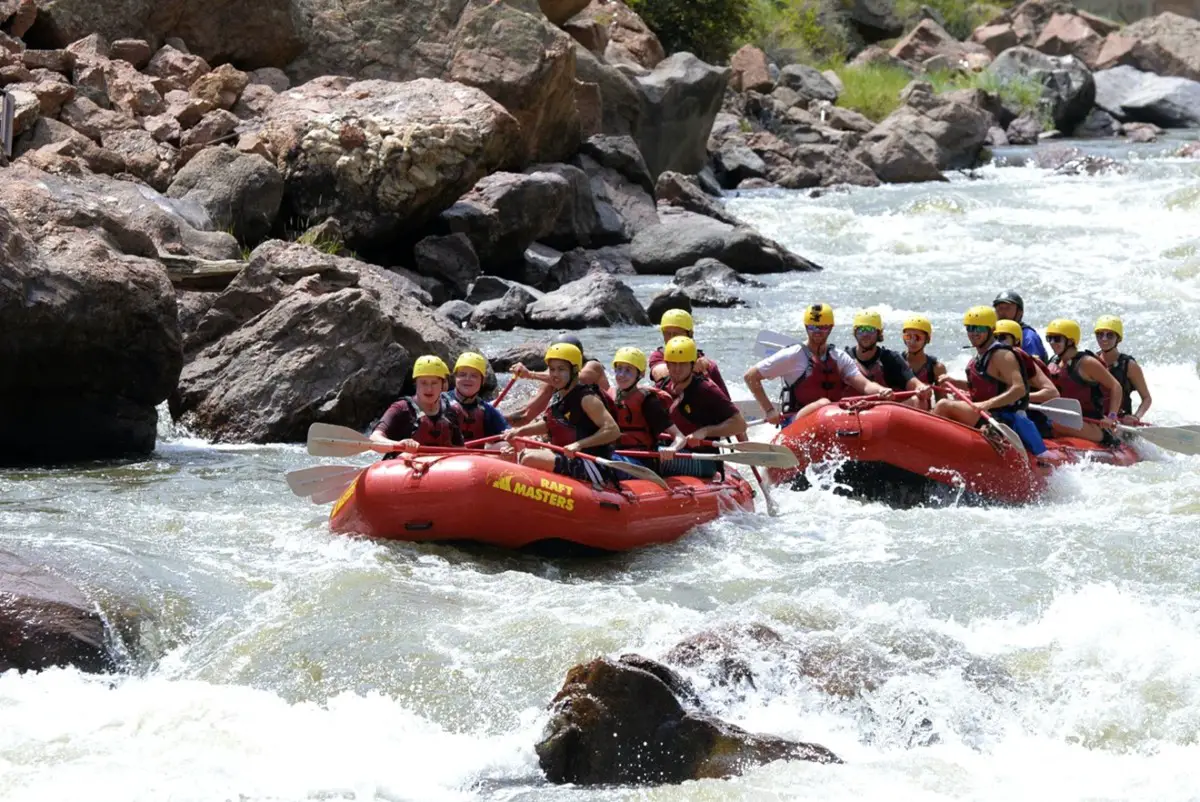Whenever someone goes rafting or kayaking on whitewater rapids, it is vital that they have a good idea of what to expect from the river and their own skill level. To clarify and simplify this process, all whitewater rapids are rated on a scale of I to VI. The rapids receive ratings based on a combination of difficulty and danger.
Rating is based on a combination of the I-VI system and water levels
A-Lake H2O-Still
I-Easy-slow moving H2O
II-Moderate-small waves
III-Moderately difficult-irregular waves-rocks
IV-Difficult-long-strong rapids
V- Extremely difficult-violent rapids
VI-Extraordinarily difficult-dangerous
Typically, high water especially in the Spring after snow melts, increases the difficulty of rapids. However, this is not always the case. Some river rapids are more technical at lower water levels. Some rapids may present particular challenges for rafts, while other rapids on rivers may be more difficult for a whitewater paddler in a kayak or canoe.
Classes of Rapids in Rivers: How are Rapids Rated
Are you a thrill-seeker always searching for your next adrenaline rush? Whitewater rafting provides an unrivaled blood-pumping experience as you navigate through some of the fastest-moving rivers in America. These rivers are typically categorized by the degree of difficulty in their rapids, ranging from Class I to Class VI. Each Class requires a unique set of skills and poses very different challenges. Join us as we make a splash and delve into a detailed exploration of the diverse Classes of Rapids in any high-rated river worldwide – your essential guide for an unforgettable adventure!
Understanding the Class III Whitewater Rapids
Tackling the wild waters of any high-rated river worldwide brings one face-to-face with different classifications of rapids. Among these categories, class III whitewater rapids are a favorite for rafting enthusiasts. Class III, or what is sometimes referred to as ‘intermediate’, offers a thrilling, adrenaline-pumping experience. It’s in these class III rapids that the real adventure of whitewater rafting begins, as one is required to maneuver around moderate, irregular waves capable of swallowing a canoe.
Understanding rapid ratings is integral to rafting, as it helps navigators maintain safety while enjoying the thrilling experience. If you’re an enthusiast who thrives on feeling every twist and turn of the whitewater under their raft, then class III whitewater rapids should be a perfect match for you. Not only does it demand a swift reaction, but it also allows you to take in the thrashing sound of rapids, making rafting one of the most exhilarating outdoor activities.
Whitewater, which takes its name from the foamy, turbulent appearance it creates, can vary greatly in its intensity. And the class system is a way to understand these variations. In rating class III whitewater rapids, the difficulty level rises to an intermediate level. The rapids are generally broader and the paths through them are more evident, and narrow. These rapids may also have powerful waves, and quick navigation is required. This is considered a big step up from class I and II, pushing your rafting skills to a new level.
Regardless of the class, no two whitewater rapids are the same. Each rapid comes with its unique challenges and fun. However, the class of rapids, such as class III, gives you a slight hint of what to expect. For example, they are characterized by powerful but predictable streams, and steep waves, and require good maneuvering skills. The raft often requires qualified guides who have profound knowledge and experience of the classification; strength, speed, and amplitude of the rapids.
Emerging successfully from class III rapids is an achievement. It’s also a call to venture into the more challenging categories ahead. But let’s remember, the thrill of rafting is not in conquering but in surviving nature’s whitewater rapids. It’s a little bit of fear and fun navigating through whirlpools and waves, and the roar of the rapids. Experiencing class III whitewater rapids, their turbulent waves, and the wild sprays of the whitewater is a challenge for any outdoor enthusiast looking for an adventure.
Experience Whitewater Rafting Trips in Class III Rapids
Now, that you’ve learned about water class types and got a taste of what Class III whitewater rapids stand for, now it’s time to actually experience whitewater rafting trips in these exciting and challenging rapids water. This adventure activity is certainly bound to give you an adrenaline rush and it’s a must-do on any adventure buff’s bucket list It was on mine.

The class III rapids are known for their harsh and unpredictable water conditions that make your rafting trips all the more thrilling. In the varied classes of rapids found worldwide, class III stands apart for its medium-level difficulty and fun factor. For enthusiasts who enjoy the rush of water against their rafting boats, a class III stream is an ideal adventure.
Speaking of global rafting scenarios, you’d find numerous high-rated rivers offering thrilling class III whitewater rapids. You just need the courage to face them and experience the adventure of a lifetime. As you embark on your whitewater rafting trips, remember that no two trips to these mysterious waters are alike. The dynamic rapids of water create an unforgettable and unpredictable outdoor journey.
Despite the uncertainties of the rapids, with an experienced guide and a spirit of adventure, rafting in whitewater is an experience to cherish. These rafting trips will expose you to the raw beauty of Mother Nature while making your heart pound with exhilaration. It’s a great outdoor experience. While rafting, the class III rapids would challenge you and require your best effort it also requires you to work with a team. It’s a true test of team spirit and provides you with a memory worth sharing around the campfire later.
During whitewater rafting trips, packing well becomes an essential part. Some colder water requires you to wear a wet suit. It is recommended to go along with experienced rafting trip organizers. These organizations have well-trained guides who’ve spent years exploring these rapids water, making your experience safer and more fun. The Guides are the guys steering the raft in the back of the boat.
It’s not just about the adrenaline, it’s also about the breathtaking views that accompany these rafting trips. Surrounded by untouched wilderness, while rafting in class III rapids you’ll witness some of the most stunning landscapes. The thrill of rafting coupled with the mesmerizing views is what makes these whitewater adventures worthwhile.
If you’re an adventure lover, rafting in class III rapids should be on your list. With well-planned and organized rafting trips, you can enjoy the thrill of these whitewater rapids without compromising on safety. So step out of your comfort zone, and embrace the environment of exciting river rapids!
Whitewater Rafting: Advanced Techniques for Navigating Class III Rapids
Among the varieties of whitewater rafting, navigating through class III rapids represents a higher level of challenge and excitement. Whether you’ve been rafting for years or just starting, understanding the classification of rapids greatly enhances your skills and safety. Class III rafting excursions offer the perfect platform for rafters seeking the rush of adrenaline, that only swift and irregular rapids can provide.
Riding Whitewater Rapids on rivers is the heart of any rafting adventure and is classified based on their intensity. The classification of rapids in rivers worldwide spans from class I (easy and predictable) to class VI (unrunnable). The classes of rapids define the level of difficulty and the techniques required for smooth navigation, with class III fitting perfectly into the ‘intermediate’ category which is where most people ride.
Pay attention to your Guide for instructions so that everyone can work together.
A successful class III rafting adventure requires:
- Both physical strength and alertness
- In these rapids, you’ll likely ride a 4-5 foot drop
- Some moderate yet irregular waves demand constant paddling and quick responses
- Correct anticipation and maneuvering are vital, especially because the rapids might hide obstacles (like rocks or trees) just beneath the surface.
Improved steering techniques are of the essence in class III rafting. Ideally, you need to position the raft at an angle with the rapid flow since it gives you better control of the raft and saves energy. Here, teamwork is essential. Clear communication and coordination within the rafting team help maintain the raft’s balance and course.
Scouting is another beneficial practice in mastering class III rapids. Pause at a safe point before action and visually analyze the formation of the rapids. Identify the route that promises the least resistance and plan your moves accordingly. For backup, always have a swift-water rescue plan ready, in case things don’t go as expected.
The thrill of conquering these ambitious rapids is undoubtedly a very cool adventure. However, your skills and the classification of the river are equally paramount. Going into class III rapids well-prepared leads to a much more rewarding rafting experience.
The world is replete with high-rated rivers, each with its unique rapids classes, including class III, making rafting quite an immersive and diverse adventure. Rafters looking for the next class III river to conquer can find numerous ranked lists online. From the tumultuous waters in North America to the intense rapids in Europe and Africa, class III rafting offers an exceptional blend of thrill and technique.
As you paddle, steer, and conquer, remember rafting is not all about innovation; it’s about the journey and the connection with nature. Enjoy the thrilling adventure that each class of rapids holds, and let the rush of the river take you places.
Conclusion:
In conclusion, understanding the Classes of Rapids is crucial for any water adventurer. The thrill and challenge offered at each level accentuate the true calling of white water rafting. When you explore any high-rated river in this Country or worldwide this knowledge works the same and will serve you well, ensuring not only an exciting journey but also a safe one. Secrets of the river are unveiled only to those who dare to confront its untamed currents, from tame class I to ferocious class VI.
Go for It!

References:
Paddle.com- Classification of Rapids, Water Levels, and Canoeists
Whitewater Guidebook- Upper Gauley River
FAQ’s
Q: What is the definition of Whitewater rafting?
A: Whitewater rafting is an adrenaline-pumping activity that allows you to navigate through swiftly moving rivers or rapids. These rapids can vary greatly in intensity, and a classification system has been assigned to understand these variations. Each classification level requires a unique set of skills and different challenges.
Q: What are class III whitewater rapids?
A: Class III whitewater rapids, also known as ‘intermediate’, are typically favored by rafting enthusiasts. They offer a thrilling experience, characterized by moderate, irregular waves that are powerful enough to swallow a canoe. In these rapids, the true adventure of whitewater rafting begins as they demand swift reactions and good maneuvering skills.
Q: Can anyone navigate class III whitewater rapids?
A: Navigating through class III rapids requires a certain skill level and an understanding of the classifications of rapids. Quick navigation is needed and the rapids also often have powerful waves. This level of rapids is considered a significant step up from classes I and II. It’s recommended to have experienced guides with profound knowledge of the classifications and conditions of these rapids.
Q: Is whitewater rafting safe?
A: Whitewater rafting is generally safe if you’re with experienced guides who understand the classifications and conditions of the rapids. However, each rapid can be different and can therefore pose unique challenges. Understanding rapid ratings is integral to ensuring safety. Also, during whitewater rafting trips, using protective gear is essential.
Q: Are class III whitewater rapids enjoyable?
A: Yes, navigating class III whitewater rapids offers both a thrilling and enjoyable experience. This level of rapids is known for its harsh and unpredictable water conditions, making the rafting trip exhilarating. Also, you will witness stunning landscapes and untouched wilderness during your trip adding to the overall enjoyment of your adventure.

